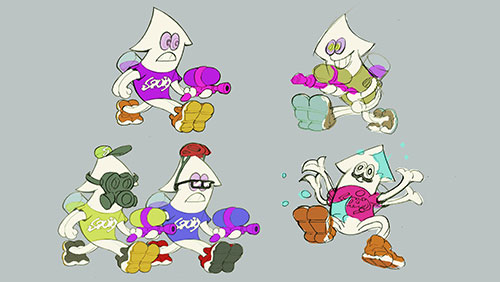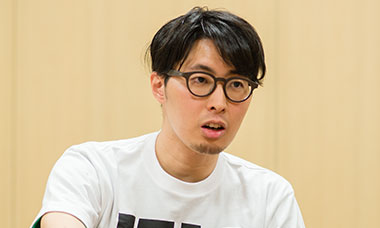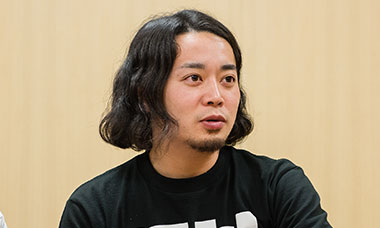So did the development go smoothly after you decided to change the character from a rabbit to a squid?
Not exactly. (laughs)
Squid are animals that shoot ink, which makes it a perfect character to shoot ink, and as Inoue-san said, “When you look at it on the map, it looks like an arrow, so that’s great.” So at first I really got into it, like, “We should make the cursor a squid shape in the UI13!” 13. UI: User Interface. This refers to the content displayed on displays like windows, menus and other elements that help users interact with and operate a computer.
But squid aren’t quite as lovable as rabbits. So in a way, it was sort of hard to turn it into a character.
So the first character we thought of was “a squid-like person”.

Or to be more precise, a “person-like squid”. The idea was that a squid had turned into a person.
The design was an anthropomorphised squid, so it wasn’t very catchy, and we weren’t yet able to clearly differentiate between the “ink-life form” and the human form.
So some of the staff started to suggest other sea creatures, like a sea angel or a sea slug. But since we’d talked about the cursor, I thought the squid was the right direction to go in. And then one day Amano-san muttered, “If you can switch between a squid and a human, then the squid should be squid-like and the human should be human-like.”
A human-like human, rather than a human-like squid.
I don’t even remember saying that. (laughs)
(laughs)
I thought, “Wow, Amano-san, that’s amazing!” (laughs) “Of course! We could have a human-like human.” We realised that we just needed to organise the design the same way we’d organised the set-up, so the ink creature would be a squid, and the human would be a person.
You had just convinced yourself that you needed to make the human like a squid.
That’s right. We’d convinced ourselves of that. But keeping the squid and human separate helped us organise our ideas, and development really sped up after that.
The character design didn’t end up changing much after that.

And before, we had called it “hiding” in the ink, but we decided to use the word “swimming” instead.
You stopped calling it an ink creature and it was able to dive like an actual squid.
That’s right. We explained to the staff that squids don’t “hide” in the ink, they “dive” in the ink. So the programmers made the camera shake, and the effect designers created splashes, and the sound effects people added not only a splashing sound, but also made it so that the background music sounded muffled when the squid is in the ink…
Around that time, we started to feel that we were gaining momentum. We had a firm basis for this game, and we knew no matter what we put in it, it would be fine.
So all sorts of people put their various sensibilities in the game. Inoue-san really pulled it all together as the art director, so it became cohesive.
For example?
You can customise the human character with all sorts of outfits , but the reason it’s all street fashion is that one of the staff members really loves that style.
The strong foundation allowed you to fill the game world with things you all loved.
That’s right. And it’s the same thing with the music. Our idea was that, in the game world, the ink-splattering Turf Wars are something kind of cool and rebellious, like skateboarding. So we added rock music because it fitted the image we had. We were really able to add all the things that we thought would work well. In a way, we might have even got a little too carried away! (laughs)
Even if we did get a bit carried away, we stayed true to our basic concept of the action game where you can switch between a human and a squid.
That’s how strong it was.
Right. It was strong enough that no matter what we added to that concept, it didn’t waver.
I think the fact that we started out by coming up with seventy ideas was a big part of why we were able to do that. And it’s not like all of the ideas we brainstormed just disappeared. A lot of those seventy ideas – for example, an idea that Amano-san had – ended up in this game.
I love online games, so I thought of the idea of doing something as a team. I wanted to incorporate a game system where instead of defeating enemies, you had to work together as a team to accomplish something.
And that original idea you had ended up in Splatoon.
Right. And because we came up with all those plans together, even if our ideas didn’t end up being used, planning them really helped to strengthen our teamwork.
All of the people on this team had had the experience, at least once, of thinking up a plan from scratch on their own, presenting it in front of others and having it rejected on the spot as not being interesting enough. And I think having gone through that experience helped to make everyone really willing to listen to people’s opinions, and also to be able to clearly and concisely give the reason for something when asked their own opinion. So they were all able to think about everyone’s ideas logically.

So even if a plan you thought up didn’t become a reality, it wasn’t all for nothing.
Right. And we were really lucky this time to have a lot of people on the team who are really deep thinkers. Even if we got stuck in the middle of development, somebody would put out an idea, and that would help us all move forward as everyone got together to refine it.
So a single idea would become a breakthrough, and help to take everything to the next level.
Right. And then if we ran into another problem, someone else would have an idea… that happened over and over again. It may sound like I’m blowing our own trumpet here, but I think we were really able to take things to a higher level on this project.
I completely understand that. You were able to create a game that was unlike any other game in the world, because you had several people on the team who were really deep thinkers. This isn’t something like, “This is what ‘X game’ looks like when Nintendo makes it,” this is something completely new.
Right. I think it’s thanks to all the people on staff that we were able to do that.
© 2024 Nintendo.